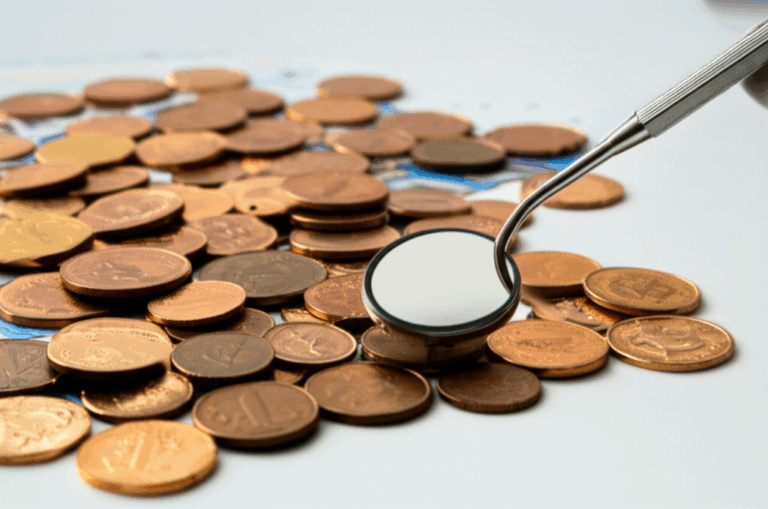
What Happens When a Dental Implant Fails? Signs, Causes, & Solutions
Short Summary:
Ever wonder what could go wrong with a dental implant? While dental implants usually work well, sometimes things don’t work out. In this article, I’ll explain why implants can fail, the warning signs to look for, and simple steps you can take. If you’re worried about a sore or loose implant, or just want to know what to expect, read on. Your smile, your health, and your happiness matter!
Table of Contents
What Are Dental Implants and How Do They Usually Succeed?
Let’s start at the beginning.
A dental implant is a small metal screw (usually made from titanium) that your dentist puts in your jawbone. It acts like the root of a tooth. After your mouth heals, your dentist puts a new tooth (crown) or bridge on top to finish your smile.
The success rates for dental implants are very high. Most research shows that dental implants work well for more than 9 out of 10 people, even after many years. In the lower jaw, more than 95% of implants last 5-10 years; in the upper jaw, it’s about 90-95%. See the table below:
| Location | Success Rate (5-10 Years) |
|---|---|
| Lower jaw | 95-98% |
| Upper jaw | 90-95% |
That’s pretty good, right? But, even though problems are not common, they sometimes happen. Before you get nervous, keep reading—let’s look at the signs, causes, and what you can do.
What Are the First Signs That a Dental Implant is Failing?
Problem: Imagine this—your implant was fine at first, but now you notice something odd. Maybe it hurts, or it feels a little loose.
Agitate: You start to worry. What if your implant is in trouble? Could it fall out? Will you need more surgery?
Solution: Don’t panic. Finding problems early can save your implant, and your dentist can help if you notice issues right away.
Here are the main signs that an implant might be failing:
- Pain—especially when chewing.
- Swelling, redness, or soreness near your implant.
- Pus, strange taste, or bad breath.
- Gums pulling back so you see more of the metal part.
- A loose or shaky feeling when you touch or bite down.
- Your crown or connector feeling wobbly or coming off.
- Tingling or numb feeling in your lips, tongue, or gums.
If you see any of these signs, don’t wait—call your dentist. The sooner you act, the better!
Physical Warning Signs: Pain, Swelling, Bleeding, and More
When your dental implant is healthy, you shouldn’t really notice it’s there. Problems start when you see or feel changes around the tooth.
Here’s what to look out for:
Some pain after surgery is normal, but ongoing or new pain is not. If biting down hurts or you need painkillers every day, something is wrong.
Some swelling right after surgery is expected, but it should get better. If your gums stay red and swollen, or if you notice bleeding that won’t stop, talk to your dentist.
Any yellow or white discharge is a warning. A bad taste or bad breath can mean infection around the implant.
If the gums around your implant start to move away, showing the metal, this could be a problem.
If your implant feels shaky, act fast.
Here’s a quick checklist for symptoms:
| Symptom | What It Might Mean |
|---|---|
| Pain when chewing | Possible infection or movement |
| Swollen gums | Inflammation or infection |
| Gum recession | Bone loss or gum problem |
| Loose implant | Bone did not connect or bone loss |
| Bad taste | Infection or pus |
What Causes a Dental Implant to Fail?
When an implant works right, it joins with your jawbone in a process called osseointegration. But sometimes, this doesn’t happen well.
Here are the main causes:
- Infection (Peri-implantitis): Germs get under your gum and hurt the bone around your implant. The gums get red, sore, and puffy, and bone starts to shrink. This is a lot like gum disease with real teeth.
- Poor Osseointegration: Sometimes, the bone just doesn’t bond tightly to the implant. Maybe the bone was too thin, or something went wrong during surgery.
- Injury or Too Much Chewing Force: Accidents, grinding your teeth, or biting hard foods can hurt implants.
- Health Problems: Badly controlled diabetes, bone problems, or smoking all make it worse. High blood sugar slows healing. Smoking keeps fresh air from getting to your gums and bone.
- Bad Mouth Care: Not brushing or flossing lets germs build up.
- Weak Bone: Not enough bone, or poor-quality bone, can’t keep the implant steady.
I’ve seen all these reasons before, and sometimes more than one happens at the same time.
When Does Implant Failure Happen? Early vs. Late Problems
Did you know implants can fail early or late?
Early failures show up in the first few months after the implant is placed. Late failures can happen years later. Let’s look at both:
Early Implant Failure
- Usually happens in the first 3-6 months.
- Often due to infection, bone not connecting, or mistakes during surgery.
- Bone doesn’t form tightly around the implant.
- Implant may feel loose or painful almost right away.
Late Implant Failure
- Can show up years later.
- Main causes include peri-implantitis, injury, too much chewing force (like from teeth grinding), and changes in health.
- The implant might wiggle after many years of working well.
Here’s a summary table:
| Failure Type | When? | Common Causes |
|---|---|---|
| Early | First 3-6 months | Infection, weak bone, bad healing |
| Late | After 1 year | Gum disease, biting, injury |
What Should You Do if You Think Your Implant is Failing?
Problem: Your implant feels weird. You’re worried and not sure what to do.
Agitate: If you ignore it, the problem could get worse. That’s scary—no one wants to lose a tooth again or go for more dental work!
Solution: Here’s what you need to do.
Here’s exactly what you should do:
If you don’t have a dentist you like, look for a specialist in implant problems or ask a good implant dental lab for help.
How Will the Dentist Check Your Implant?
When you see your dentist, here’s what usually happens:
If infection is the problem, they might take a sample, or give antibiotics. Sometimes special cleaning tools or dental lasers clean the area.
Quick tip:
If your dentist finds a problem early, the implant can often be saved—so act fast!
What Are the Treatment Options for a Failed Dental Implant?
Let’s be honest—hearing you need treatment isn’t fun. But the good news is, dentists have a lot of ways to help.
Non-Surgical Treatments (Best for Early Problems or Mild Gum Infections):
- Professional Cleaning: Dentists use special tools to clean the area really well.
- Antibiotics or Mouth Rinses: Sometimes medicine clears up infection fast.
- Laser Treatment: New dental lasers can kill germs gently and help healing.
Surgical Treatments (For Bigger Problems):
- Implant Removal: If the implant is loose or there’s a lot of infection, taking it out may be the only choice.
- Bone Graft: If bone is lost, the dentist can place new bone material in the space. Your body then builds new bone over time.
- Guided Healing: Special covers or growth helpers can help the gums and bone heal.
- New Implant: Later, a new implant can go in—once you are better.
For some people, a bridge or a removable denture may be easier than a new implant. Good new teeth from a skilled crown and bridge lab will look real and let you chew well.
What Can You Do to Prevent Dental Implant Failure?
Most people who take care of their implants won’t have a problem. Here’s my best advice to keep your implants healthy:
Before Surgery
- Pick a Good Dentist: Look for clinics with good reviews and dentists who do lot of implants.
- Take Care of Your Health: If you have diabetes or other health problems, work with your doctor.
- Stop Smoking: Quitting tobacco helps you heal better.
- Get Scans or X-rays: Make sure your dentist checks your bone well before surgery.
After Surgery
- Brush Twice and Floss Every Day: Don’t slack! Germs love to hide around implants.
- Go for Check-Ups: Your dentist can see problems before they grow.
- Use a Night Guard: If you grind your teeth, ask your dentist about a night guard dental lab for a custom protector.
- Skip Hard Foods: For a few days after surgery, stay away from nuts and hard candy.
- Do All Cleaning Steps: If your dentist says to use a gentle mouthwash or special brush, do it.
Can You Try Again After a Failed Dental Implant?
Here’s some good news: a failed implant doesn’t mean you must give up on a nice smile.
- Dentists can often try again after fixing the problem.
- First, your dentist will treat infection and fix any bone loss with a bone graft.
- In most cases, after a healing time, a new implant can be put in.
Studies show that 60-80% of people can get a new implant in the same spot after failure, if the main problem is fixed. And if an implant won’t work, other options—like dental bridges or removable dentures—are there. A high-quality removable denture lab can make new teeth that look and feel good.
Questions and Answers
Q: Is it normal to feel pain years after an implant?
A: No. Old pain or new pain means you should visit your dentist. Even years later, gum infection or bone loss could be why.
Q: Can smoking really make my implant fail?
A: Yes! Smokers have up to three times the risk of losing an implant as non-smokers.
Q: Will insurance pay for a new implant if mine fails?
A: Maybe. Check your plan—many dental plans cover fixes, but not always a full redo.
Q: Are some materials better for implants?
A: Titanium is most common and works best. Sometimes, zirconia is good, too.
Q: How do I know if I’m at higher risk?
A: Risks include bad mouth care, diabetes, smoking, gum disease history, and weak bone.
Summary: Key Points to Remember
- Dental implants usually go well, but problems can happen.
- Warning signs are pain, swelling, loose implants, and gum changes.
- Act quickly! Call your dentist if you notice any problems.
- Treatments go from cleaning and medicine to surgery and bone grafts.
- Keep your implants safe with good cleaning, dental checkups, and good advice.
- Most people with failed implants can try again or use a bridge or dentures.
- A reputable china dental lab gives you quality crowns, bridges, and dentures to fix your smile after implant trouble.
Look after your smile—trust the pros, act fast on warning signs, and keep smiling!
References:
- American Academy of Periodontology: “Dental Implants” (periodontics.org)
- International Journal of Oral & Maxillofacial Implants, 2019
- Mayo Clinic: “Dental Implant Surgery”
- Clinical Oral Implants Research, Vol. 26, 2015








